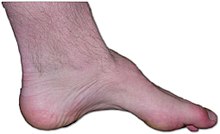Distal hereditary motor neuropathy type V
| Distal hereditary motor neuropathy type V | |
|---|---|
| Other names | dHMN V |
Distal hereditary motor neuropathy type V is a particular type of neuropathic disorder. In general,
Signs and symptoms
Onset usually occurs within the first two decades of life, commonly in the teenage years or the twenties. Life expectancy is normal.

High arch of the foot (pes cavus) is common. Patients also have trouble controlling their hands, due to muscle loss on the thumb side of the index finger and palm below the thumb.[4] It is rare for a person with this disorder to lose the ability to walk, though changes in gait may occur later in life.[5]
Frequency of this disorder is unknown.[6]
Genetics
dHMN V has a pattern of
Diagnosis
In an individual with dHMN V,
Treatment
Physical therapy is the predominant treatment of symptoms. Orthopedic shoes and foot surgery can be used to manage foot problems.[5]
References
- ^ S2CID 73528377.
- S2CID 27780275.
- ^ S2CID 21874798.
- ^ "Distal hereditary motor neuropathy, type V". Think Genetic. 10 June 2016. Archived from the original on 13 March 2017. Retrieved 5 November 2016.
- ^ S2CID 43661842.
- ^ Reference, Genetics Home. "distal hereditary motor neuropathy, type V". Genetics Home Reference.
- S2CID 22868888.
- PMID 22703882.
- PMID 12690580.
- S2CID 665324.
